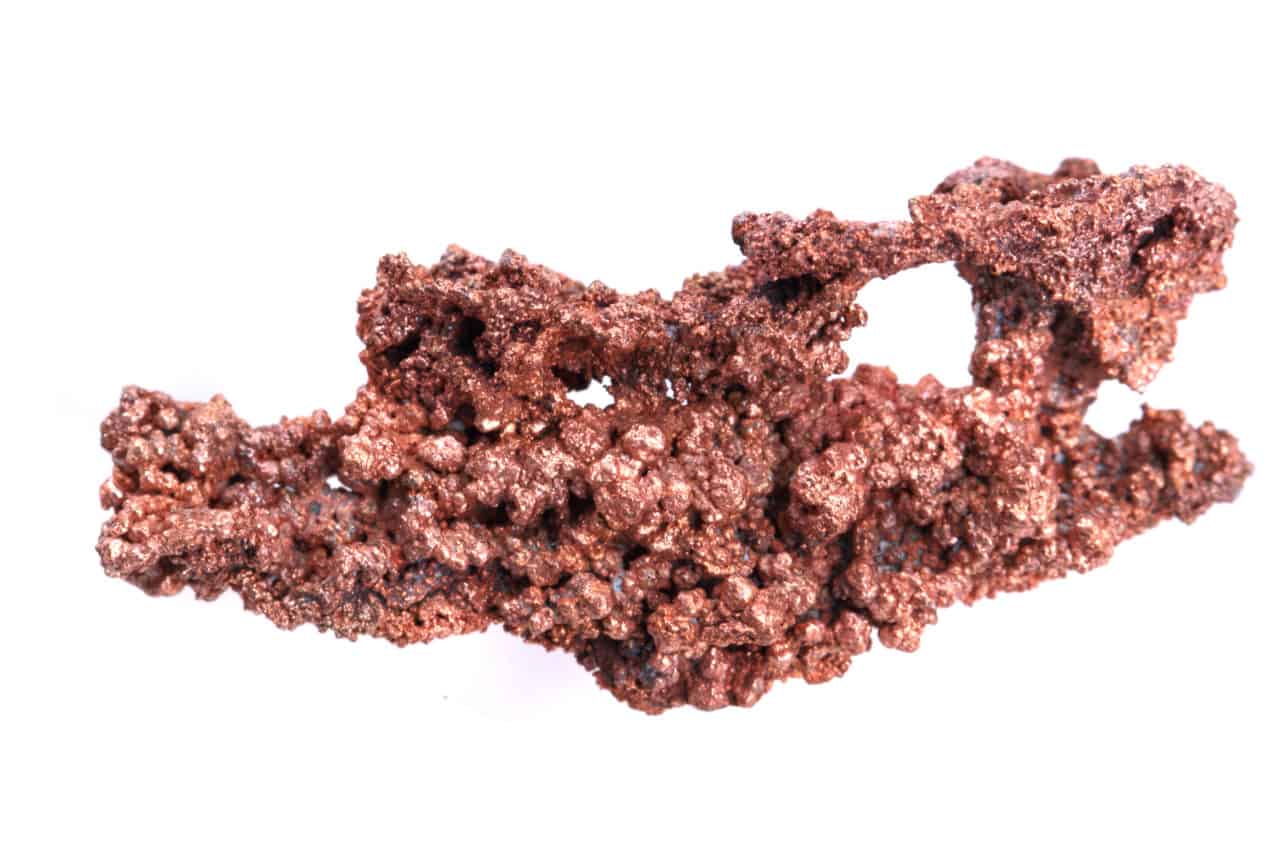Copper
Copper (Cu) as a minable resource led to key technological developments of human civilization since the end of the Stone Age. Today, copper exploration, production, and technology remain key ingredients in our society. Anticipated demand for copper will only increase over the next decade as innovations developed with this extremely useful metal have become ubiquitous in telecommunications, space-age battery technology, and key infrastructure projects across the globe.
The Copper Age
Copper as a resource is a keystone in the rise of human society. This began with the use of copper by early peoples. Around 4000 BCE, the Chalcolithic (copper-stone) Age enabled early human societies to manipulate native copper (Cu) into tools, weapons, and ornaments. The technology necessary to extract copper from sulfides, oxides, silicates, and carbonates was still out of reach. Over the next three millennia, copper was utilized by cultures spanning the globe, beginning in the Middle East and stretching across all continents. An island in the Mediterranean was so rich in native copper at the surface that the Greeks eventually named it Cyprus, their word for copper.
Copper as Minable Resource
Today, copper can be extracted from numerous complex ores of diverse mineralogy. In addition to naturally-occurring, native copper (Cu), the main copper minerals are chalcopyrite (CuFeS2), chalcocite (Cu2S), bornite (2Cu2S·CuS·FeS), cuprite (Cu2O), chrysocolla ([Cu,Al]2H2Si2O5[OH]4·n[H2O]), azurite (2CuCO3·Cu[OH]2), and malachite (CuCO3·Cu[OH]2). These copper-sulfides and copper-oxides are associated with complex geology, however, the exploration for copper is well-documented and key principles can be used to determine exploration targets.
Copper Genesis and Exploration
Copper is concentrated in the upper crust of the earth by several geologic processes. These areas of concentration are directly related to tectonic and hydrothermal activities that relate to specific metallogenic epochs. Of primary interest are porphyry copper and skarns, with sediment-hosted stratiform copper and iron oxide copper-gold deposits (IOCG) also contributing significantly to copper mineralized zones.
Porphyry Copper and Skarn
A porphyry is a large, intrusive body of igneous rock that is crystal-rich. These large bodies intrude into the shallow crust from below the surface. In North and South America, these bodies can be found in tectonic regimes associated with mountain-building processes along the western boundaries of the continents. The age of these deposits stretches from the Mesozoic (~200 million years ago) to the Cenozoic (<65 million years ago). To areal extent, these targets are typically narrow and linear.
From a resource perspective, porphyry copper deposits account for over 70% of global copper production and are the primary source of molybdenum which is produced as a byproduct. The mineralogy of copper deposits is diverse, however copper-bearing sulphides such as chalcopyrite, bornite, chalcocite, and others dominant the assemblage. These minerals exist in veins, fractures, and breccia pipes where hydrothermal fluids deposit the ore. High-grade zones exist where multiple copper-rich intervals intersect.
Skarn is a geological body that resides in close proximity to a porphyry deposit and has been altered through metasomatic processes involving fluid flow. This metamorphic zone consists of carbonate rocks that have been diagenetically altered with significant amounts of silicon, aluminum, iron, and manganese. When a limestone or dolostone body is intruded by the granitic rocks of a porphyry and significant replacement of carbonate by silicate minerals results in rich ore, a skarn can be described as a deposit.
Sediment-hosted stratiform copper
A significant amount of historic copper production and current copper reserves can be found in sediment-hosted or stratabound copper deposits. These copper ore deposits typically co-occur with silver, and several well-known, stratabound copper deposits have been exploited to varying degrees of success in the Mesoproterozoic sedimentary rocks of Montana and Idaho. Stratabound copper deposits have also been discovered in geographically diverse areas including Iran, the Andes mountains of Chile and Peru, and across southern Africa.
The study of these deposits indicates that copper mineralization occurs post-depositionally and has a strong structural control on high-concentration zones. Historically, geologists targeted sedimentological units of the proper characteristics (permeability and rock-type) although more recent work has suggested that structural controls, such as faults and folds, play a much larger role in determining the key copper-rich targets that provide the most economic resources. A combination of ideal stratigraphic units, structurally enabled hydrothermal fluid flows, and appropriate chemical interactions at depth result in the richest sediment-hosted stratiform copper deposits.
Iron oxide copper-gold deposits (IOCG)
Models for iron oxide copper-gold deposits (IOCG) incorporate multiple geological processes including a magmatic-hydrothermal genesis and structural control. Essentially, IOCG deposits are associated with large magmatic intrusions from deep within the crust. The interaction zones proximal to the intrusion are where these deposits can be found.
The largest IOCG deposits discovered are almost entirely Precambrian in age (>540 million years old), and exist within the oldest continental rocks on earth, referred to as cratons. Smaller IOCG deposits have been identified in rocks younger than the Precambrian, and these typically are associated with convergent boundaries such as the Andes mountains where the Pacific Plate is subducted underneath the South American plate.
Burgex Mining Consultants has decades of experience in copper exploration and production. We have the skills and tools to assist you in every phase of your project from acquiring mineral rights, sampling, geochemical analyses, resource evaluation, and mine-planning. Contact us today for all your mining service needs!
References
Boleneus, D.E., Applegate, L.M., Stewart, J.H., and Zientek, M.L., 2005. Stratabound Copper-Silver Deposits of the Mesoproterozoic Revett Formation, Montana and Idaho, United States Geological Survey, Scientific Investigations Report 2005-5231, 66 pp.
Groves, D.I., Bierlein, F.P., Meinert, L.D., and Hitzman, M.W., 2010. Iron Oxide Copper-Gold (IOCG) Deposits through Earth History: Implications for Origin, Lithospheric Setting, and Distinction from Other Epigenetic Iron Oxide Deposits, Society of Economic Geologists, Economic Geology, v.105, pp. 651-654.
Maiden, K.J., and Borg, G., 2011. The Kalahari Copperbelt in Central Namibia: Controls on Copper Mineralization, Society of Economic Geologists Newsletter, October 2011, No. 87, 7pp.
Sinclair, W.D., and Goodfellow, W.D., 2007. Porphyry deposits, Geological Association of Canada, Mineral Deposits Division 5, 21 pp.

